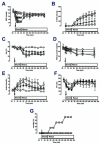Systemic release of cytokines and heat shock proteins in porcine models of polytrauma and hemorrhage*
- PMID: 21983369
- PMCID: PMC3383056
- DOI: 10.1097/CCM.0b013e318232e314
Systemic release of cytokines and heat shock proteins in porcine models of polytrauma and hemorrhage*
Abstract
Objective: To define systemic release kinetics of a panel of cytokines and heat shock proteins in porcine polytrauma/hemorrhage models and to evaluate whether they could be useful as early trauma biomarkers.
Design: Prospective observational study.
Setting: Research laboratory.
Subjects: Twenty-one Yorkshire pigs.
Interventions: None.
Measurements and main results: Pigs underwent polytrauma (femur fractures/lung contusion, P), hemorrhage (mean arterial pressure 25-30 mm Hg, H), polytrauma plus hemorrhage (P/H), or sham procedure (S). Plasma was obtained at baseline, in 5- to 15-min intervals during a 60-min shock period without intervention, and in 60- to 120-min intervals during fluid resuscitation for up to 300 min. Plasma was assayed for interleukin-1β, interleukin-4, interleukin-5, interleukin-6, interleukin-8, interleukin-10, interleukin-12/interleukin-23p40, interleukin-13, interleukin-17, interleukin-18, interferonγ, transforming growth factor-β, tumor necrosis factor-α, heat shock protein 40, heat shock protein 70, and heat shock protein 90 by enzyme-linked immunosorbent assay. All animals after S, P, and H survived (n = 5/group). Three of six animals after P/H died. Interleukin-10 increased during shock after P and this increase was attenuated after H. Tumor necrosis factor-α increased during the shock period after P, H, and also after S. P/H abolished the systemic interleukin-10 and tumor necrosis factor-α release and resulted in 20% to 30% increased levels of interleukin-6 during shock. As fluid resuscitation was initiated, tumor necrosis factor-α and interleukin-10 levels decreased after P, H, and P/H; heat shock protein 70 increased after P; and interleukin-6 levels remained elevated after P/H and also increased after P and S.
Conclusions: Differential regulation of the systemic cytokine release after polytrauma and/or hemorrhage, in combination with the effects of resuscitation, can explain the variability and inconsistent association of systemic cytokine/heat shock protein levels with clinical variables in trauma patients. Insults of major severity (P/H) partially suppress the systemic inflammatory response. The plasma concentrations of the measured cytokines/heat shock proteins do not reflect injury severity or physiological changes in porcine trauma models and are unlikely to be able to serve as useful trauma biomarkers in patients.
Figures






Comment in
-
The immune response to trauma: is it immunoinflammatory, immunoregulatory, or both?*.Crit Care Med. 2012 Mar;40(3):1011-2. doi: 10.1097/CCM.0b013e318236eab6. Crit Care Med. 2012. PMID: 22343860 No abstract available.
References
-
- Keel M, Schregenberger N, Steckholzer U, et al. Endotoxin tolerance after severe injury and its regulatory mechanisms. J Trauma. 1996;41(3):430–437. discussion 437-438. - PubMed
-
- Majetschak M, Flach R, Heukamp T, et al. Regulation of whole blood tumor necrosis factor production upon endotoxin stimulation after severe blunt trauma. J Trauma. 1997;43(6):880–887. - PubMed
-
- Majetschak M, Flach R, Kreuzfelder E, et al. The extent of traumatic damage determines a graded depression of the endotoxin responsiveness of peripheral blood mononuclear cells from patients with blunt injuries. Crit Care Med. 1999;27(2):313–318. - PubMed
-
- Majetschak M, Borgermann J, Waydhas C, et al. Whole blood tumor necrosis factor-alpha production and its relation to systemic concentrations of interleukin 4, interleukin 10, and transforming growth factor-beta1 in multiply injured blunt trauma victims. Crit Care Med. 2000;28(6):1847–1853. - PubMed
-
- Ditschkowski M, Kreuzfelder E, Majetschak M, et al. Reduced B cell HLA-DR expression and natural killer cell counts in patients prone to sepsis after injury. Eur J Surg. 1999;165(12):1129–1133. - PubMed
Publication types
MeSH terms
Substances
Grants and funding
LinkOut - more resources
Full Text Sources
Medical
Research Materials

